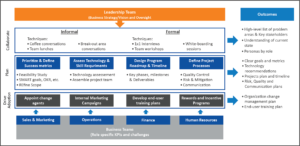Analytics Roadmap: The Elusive Art of Analytics Goal-setting
Analytics is at the top of almost every company’s investment agenda today. The market for Big Data and Analytics is expected to only keep growing as the world economy recovers from the COVID-19 crisis. A study by the U.S. Bureau of Labor Statistics suggests that by 2030 there will be a 30% growth in the field of data analytics, with almost 90% of organizations considering data to be a critical asset for remaining competitive.
But even with the increasing adoption of analytics and cutting-edge business intelligence tools, the success rates of analytics initiatives are appalling. This is where we find the need for the effective development of an analytics roadmap for guiding the analytics project, both in-house or in partnership with analytics outsourcing vendors.
However, when it comes to setting up their analytics process, organizations often misconstrue an existing data strategy as the replacement for an analytics roadmap.
Analytics Roadmap vs Data Strategy
A data strategy is an initial introspection into a company’s objectives for financing analytics projects. It enables the enterprise to understand how its data can be leveraged to open up new avenues for business expansion and profits while improving on current business processes.
Some of the factors that you need to account for while setting up your data strategy are the quality of your existing data, the type of data, and the opportunities it offers post-analysis. You also need to consider ownership of the data, along with data security and privacy regulations. Last but not the least, if your enterprise is capable of handling the analytics and supporting the internal collaboration.
An analytics roadmap is then created to convert the objectives of the data strategy into an actionable plan, that can lead the objectives to fruition. Setting up this framework enables businesses to gauge the value offered by each analytics initiative, along with the associated restrictions. This is crucial for the efficient allocation of human resources, analytics bandwidth, and time.
The roadmap details the daily activities needed to succeed at achieving the data strategy. The details include the need for specific personnel, required skillsets and expertise, and the timeline you need to adhere to. The roadmap also helps to plan out when the phasing of different business activities required to achieve the end goal, so that no processes overlap, and efficiency is optimal.
While the data strategy outlines the metrics needed to achieve the business objectives, the roadmap measures the metrics determining the fulfillment of the target. But why do you even need an analytics roadmap if your business is already running smoothly?
Why You Need an Analytics Roadmap
Carrying out enterprise-wide change is always more efficient when you are organized, aware of the purpose, and coordinate activities across business units and capabilities. But a roadmap for your analytics initiatives can not only help you integrate your business goals seamlessly with technological upscaling, but plan strategically for any business requirements.
Having a robust roadmap can enable you to analyze larger datasets with targeted analytics. It allows you to capitalize on long-term business opportunities as well as fast gains with real-time actionable insights. Having a strategic rollout also helps mitigate risks, and deliver progressive value to your enterprise.
Analytics planned right, can impact your organization as a whole, and have a positive impact on every business function from R&D and Demand Sensing, to Marketing, Sales, and Supply Chain Management. Analytics is the cornerstone for actionable business intelligence delivering value.
Common Errors to Avoid while Planning Analytics
As mentioned earlier, and detailed in our article titled Four Mistakes in the Life of an Analytics Project, the success rates of analytics initiatives are quite disturbing. While there are several reasons for the failure of analytics projects, four common mistakes organizations make are:
- Lack of alignment with business problems
- Lack of leadership involvement
- Little or no collaboration
- Lack of empathy for the end-user
At the outset, these mistakes may seem too obvious to have been ignored. However, most of it is easier said than done. While it is common for consultants to suggest having a clear analytics strategy and roadmap before building a solution, companies still struggle to implement this advice. It is the effective management of people, processes, and technology, that is key to successful implementation and scenario planning for analytics.
A Framework for Successful Analytics Implementation
The following framework shows a layered approach, addressing all the roadblocks to analytics success.
Course5’s Framework for Successful Analytics Implementation
Leadership
Involvement from leadership is an important aspect. Senior leadership can provide perspective on the overall business vision. When they oversee analytics projects, they help keep analytics program outcomes aligned with this vision and ensure that the business is investing in the right direction.
Collaboration
Most business stakeholders today have an appreciation for what data and analytics can do for them. However, their biggest challenge is in closing the gap between business needs and insight needs. Even when analytics teams proactively ask business teams about their goals to map them to insight needs or ask how they could help them, they often receive vague, ’whole wide universe’ answers that are not helpful at all.
But analytics teams have an internal sales role, as partners in their stakeholders’ success rather than just providers of data or insights.
As analysts, a consultative, partnership mindset is key to building trust with business stakeholders. Sometimes joining colleagues for coffee – either in-store or even remotely via video conference – can help create a relationship built on mutual understanding and empathy due to better communication. If we ask people what their problems are in formal meetings, we may not get the best answers. Informal conversations can provide a decent place to start because these can help identify the problems that are top of mind. Some questions that could help you make the most of conversations are:
- What is a typical day in your life?
- What are your daily activities, deliverables, and KPIs?
- Which tools do you use during your workday? Do you think it could be improved?
- What kind of data and information do you need for making decisions?
- How much time in your day do you spend drawing insights from your data?
- What do you miss or what would you really like to have?
You can then have follow-up discussions to refine requests to specific, solvable problems. To aid these discussions, you can adopt an ’Insights Funnel’ approach, to drill down and check if there is an insight gap. These insights could be factual, causal, predictive, or prescriptive in nature, depending on the company’s analytics maturity.
Planning
Once you have a list of specific use cases, you can go on to articulate the business value of the use cases with well-defined scope and desired outcomes and then prioritize them based on impact, technical complexity, and organizational considerations.
When it comes to technology, the best tool used without a plan is not as good as an average tool supported by a well-regarded plan with broad alignment.
You obviously cannot migrate from the current situation to the future state overnight. But you can drive the creation of a maturity model, in which the “Current” and the “Desired” state are situated at opposite ends of the spectrum with a number of intermediate levels or milestones in between, depending on the overall timeline. The first milestone involves the most important and/ or urgent deliverables and activities. Consider each milestone as a sub-project to be executed as part of the overall analytics program. For each sub-project, analysts must clearly establish a project plan with a detailed work breakdown structure that is well-considered and ready to be executed.
Driving Adoption
This is the most crucial aspect of ensuring successful implementation. Change is not easy. More often than not, employees are going to resist any change in the way they were used to working. While leaders can communicate to users why the change will be worthwhile to them, it will take more than that to motivate users to adopt new ways of working. Here are some ways to encourage adoption:
- Change Agents
Involve the end-user right from the planning phase of the project. This will not just help them gain perspective on their daily activities and challenges but may also convert them into your change agents who can market the benefits of an upcoming solution. - Internal Marketing Campaigns
Create a buzz about the upcoming project. Start advertising your initiative early, create a go-to-market strategy, conduct roadshows, and launch events. - End-user Training
Even the most intuitive technology has a learning curve. End-user training programs, self-help documentation, and user helplines can be effective ways to increase the speed of adoption. And training programs are not “one and done” initiatives. They require frequent refreshing. But self-service reporting and analytics platforms make the decision-making process simpler, with easy access to crucial insights from the tool’s descriptive, predictive and prescriptive analytics capabilities. - Reward and Incentive Program
Lynn Vojvodich, Chief Marketing Officer at Salesforce, suggests incentivizing employees with generous rewards, to motivate them toward assimilating with the program. Salesforce customers have boosted adoption levels using point-based rewards programs, team competitions, and even gamification.
External Assistance for Analytics Initiatives
Even if you have an existing analytics roadmap, you can still benefit from an external consultation. Liaising with an experienced consultant can help you have a fresh and objective perspective on your existing analytics and business goals. You can also pool in a lot more expertise than you already have onboard.
We at Course5 Intelligence, help businesses create their analytics strategy and roadmap in a way that defines their current state, where they would like to be, and how they can get there through seamless digital transformation. The guiding principles of Course5’s approach are based on the framework mentioned above.
Course5 uses a combination of these principles to help design successful analytics strategies and roadmaps for our clients. As part of our strategic partnership with leading hi-tech products manufacturer since 2014, we have been driving a long-term Analytics journey for their U.S. and Indian businesses. Using the principles mentioned in this article, we helped the client implement successful projects from the data foundation phase (in 2014) to a prescriptive and predictive solutions phase (2019 and onwards).
Over the years, Course5 has helped the client save over USD $100Mn through cost efficiencies and helped generate approximately USD $2Bn in revenue through various customer and marketing analytics programs.
In our experience, successful analytics programs begin with an end in mind, focus on collaboration and drive adoption. If you have made a few mistakes, don’t let them get you down. Bounce back by being methodical and framework-driven and you will be well on your way toward setting your analytics program right.
Get in touch with us if you need a helping hand with setting up or strengthening your roadmap for successful analytics.
Note: This article was recently updated to focus the content on the importance and implementation of Analytics Roadmaps.

Smriti Misra
As an accomplished analytics solutions and pre-sales professional, Smriti has about 10 years of demonstrated success in various roles from Java Development and DevOps, to...Read More

Don’t miss our next article!
Sign up to get the latest perspectives on analytics, insights, and AI.








